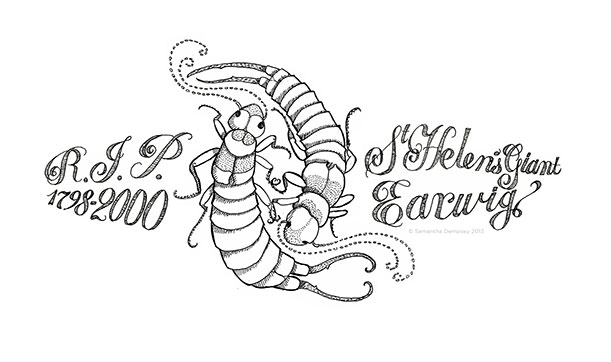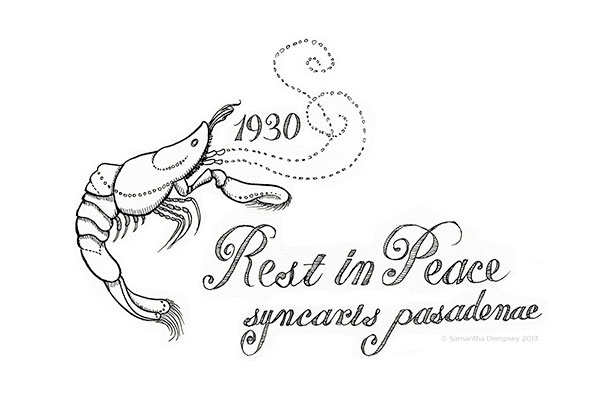These Tattoos Honor Lost, Not-So-Loved Species
To overcome how people tend to care only about cute endangered animals, Samantha Dempsey designed and distributed temporary tattoos of ugly extinct species
/https://tf-cmsv2-smithsonianmag-media.s3.amazonaws.com/filer/20130925100020Earwig-tattoo-on-model-Samantha-Dempsey-web.jpg)
As a freshman at the Rhode Island School of Design, Samantha Dempsey made a series of 18 watercolors about humankind’s relationship with infectious diseases. She enjoyed the project but realized in the process that the artwork failed as a communication device. People, she says, didn’t quite understand that one painting, for example, was about Oliver Wendell Holmes discovering the communicability of childbed fever.
Samantha Dempsey has designed tattoos of little-known extinct creatures, like this species of shrimp, Syncaris pasadenae. Image courtesy of Samantha Dempsey.
“I realized that I wanted to be making art that didn’t describe science but could actually affect the science that was out there and affect our relationships with that science. I guess it’s more science communication activism,” says Dempsey. “I wanted to make art that could do things instead of just talk about what already existed.”

Image courtesy of Samantha Dempsey
So, while earning her BFA in illustration, the artist took classes at both RISD and Brown University to fulfill a science communication minor of her own design.
By this past spring, Dempsey, a senior in her final semester, was thinking like a true activist. She had identified a problem: when it comes to endangered species, people seem to only care about animals that are cute and charismatic, like the giant panda or some exotic bird. “It is upsetting that, though other animals are just as important to our genetic diversity as a planet, no one pays attention to them,” she says. So she devised a solution: the Extinction Tattoo Project.

Image courtesy of Samantha Dempsey
For her project, Dempsey designed tattoos of an oblong rock snail, a St. Helena giant earwig and a Pasadena freshwater shrimp—three extinct, and rather ugly, creatures. Like commemorative tattoos for loved ones who has passed, Dempsey’s designs include references to the species life spans. She writes “in memoriam 1881-2000″ next to the oblong rock snail, for example, which is thought to have died out due to habitat loss in the Cahaba River in Alabama, and “R.I.P. 1798-2000″ for the ill-fated giant earwig.
With the designs, she then launched a campaign to make the public aware of these often ignored animals. She created posters, photoshopping the tattoos onto portraits of models, and hung them around her campus, and she distributed temporary tattoos to students and faculty.
“They went like candy,” she says.

Image courtesy of Samantha Dempsey
For this first foray into temporary tattoo production, Dempsey chose animals that, in her eyes, had at least one redeeming physical quality despite their otherwise homely appearances. For the Pasadena freshwater shrimp, it was its curly antennae, and with the St. Helena giant earwig, it was the sweeping shape of the insect’s pincers. “I tried to find what was beautiful about each of the ugly animals,” she says. Guided by this endearing feature, Dempsey determined the overall layout of the tattoo.
“Because they were extinct, there aren’t a lot of photographs of them, or the photos are hard to find,” Dempsey explains. Some of the tattoos are drawn directly from images but others are a blend of scientific illustrations she could find of both the particular species and of modern animals related to it. “It was a little bit of sleuth work,” she says. “There is slight artistic interpretation as well, because it had to fit into the tattoo style.”

Image courtesy of Samantha Dempsey
Dempsey distributed nearly 100 temporary tattoos, mostly around RISD, to gauge interest. “It was mostly people looking at them and being sort of whaaa, not really sure how to feel, and then deciding, wait, this is great!” she says. Her inventory vanished in just 30 minutes or so. “I would love to produce them at mass scale,” she adds. “There are a lot of ugly animals. The blobfish is pretty awful, but important.”

Image courtesy of Samantha Dempsey
In her projects, Dempsey aims to make science accessible, to make it hip, mainstream and fun. “Design can really affect the public’s relationship with science and how we view it. Instead of some lab coat, old, white man telling us ‘blah, blah, blah, blah, blah. Eat your vegetables,’ the science that is out there should really be as exciting to everyone as it is to the scientists themselves,” she says. “That is what drives me.”
/https://tf-cmsv2-smithsonianmag-media.s3.amazonaws.com/accounts/headshot/megan.png)

/https://tf-cmsv2-smithsonianmag-media.s3.amazonaws.com/accounts/headshot/megan.png)